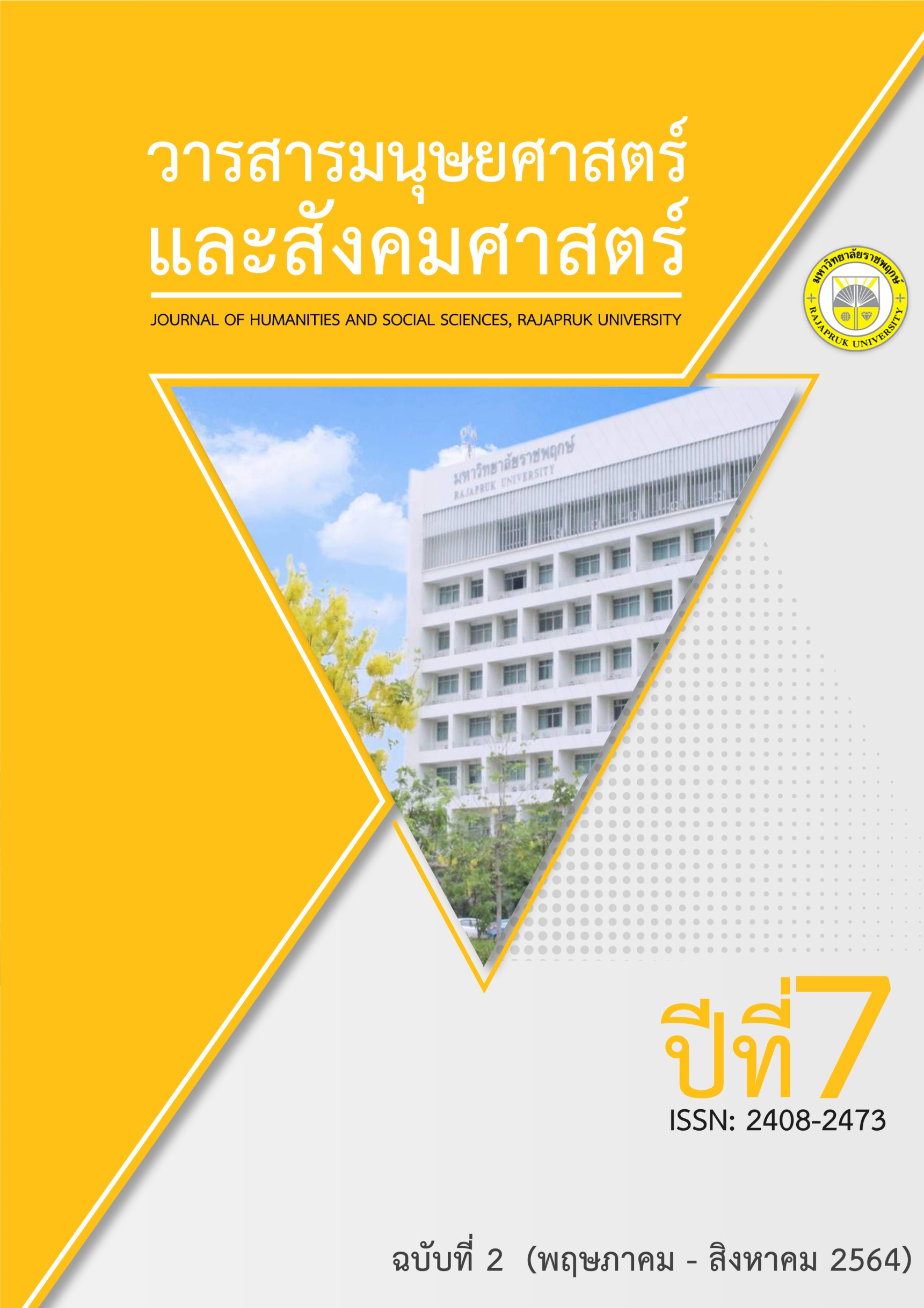The Traditional Activity Participation Model of Lampang Community for Conservation and Inheritance Culture through Creative Tourism: Ban Sop-Luen
Main Article Content
Abstract
The purposes of this study were; 1) to analyze traditional wisdom of Lampang community participation for conservation and inheritance the local identity culture: Ban Sop-Luen, 2) to classify traditional wisdom through the integration of participatory activities of Lampang community for conservation and inheritance the local identity culture: Ban Sop-Luen, and 3) to link the traditional activity participation model of Lampang community for conservation and inheritance the local identity through creative tourism: Ban Sop-Luen. The sampling group consisted of 35 local wisdom scholars, seniors and community representatives using a purposive sampling method. The data obtained from observation, in-depth interviews and focus group discussions using participatory action research.
The results revealed that; 1) the cultural attractions in Ban Sop-Luen consist of ancient temples, historic site with historical traces remain visible, ancient architecture of local buildings, urban structures and ruins. 2) the local wisdom of the villager in Ban Sop-Luen is the discovery of each and applied in daily life. Solving problems and creating morale until crystallized the knowledge in the community. 3) The local wisdom of the villager in Ban Sop-Luen classify as: art wisdom, handicraft wisdom, herbal wisdom, folk medicine wisdom, food wisdom, wisdom of Thai classical dance music and folk performances, and ritual wisdom. 4) The traditional activity model of villager in Ban Sop-Luen for creative tourism, consisting of the traditional activity model base on the way of life, traditions, beliefs, and the traditional activity model base on wisdom.
Article Details
References
การท่องเที่ยวแห่งประเทศไทย สำนักงานจังหวัดลำปาง. (2558). ลำปางเมืองไม่หมุนตามกาลเวลา. ลำปาง.
การท่องเที่ยวแห่งประเทศไทย. (2558). ประเภทการท่องเที่ยว. ค้นเมื่อวันที่ 30 มีนาคม 2562, จาก http://123.242.133.230/masterplan_area/userfiles/files/Tourism.pdf
กิตติศักดิ์ กลิ่นหมื่นไวย. (2561). แนวทางการส่งเสริมการท่องเที่ยวเชิงวัฒนธรรมชุมชนท่ามะโอ อำเภอเมือง จังหวัดลำปาง. วารสารศิลปศาสตร์ มหาวิทยาลัยแม่โจ้, 6(1): 131-147.
เกษม กุณาศรี และคณะ. (2560). การเลือกเอกลักษณ์ท้องถิ่นสำหรับพัฒนาผลิตภัณฑ์ชุมชน: กรณีศึกษากลุ่มวิสาหกิจชุมชนบ้านห้วยชมพู. Journal of Community Development Research (Human and Social Sciences), 10(4): 86-97.
คัชพล จั่นเพชร และ พิทักษ์ ศิริวงศ์. (2560). การบูรณาการทุนทางวัฒนธรรมสู่การเป็นแหล่งท่องเที่ยวเชิงสร้างสรรค์ด้วยกระบวนการมีส่วนร่วมของชุมชน: กรณีศึกษา ชุมชนบ้านชากแง้ว อำเภอบางละมุง จังหวัดชลบุรี. Journal of Community Development Research (Humanities and Social Sciences), 10(1): 31-148.
ทรงวุฒิ เรืองวาทศิลป์. (2550). การมีส่วนร่วมของชุมชน ในการจัดการศึกษาในพื้นที่บริการของโรงเรียนล้อมแรดวิทยา อำเภอเถิน จังหวัดลำปาง. มหาวิทยาลัยเชียงใหม่.
บุญเลิศ จิตตั้งวัฒนา. (2548). การพัฒนาการท่องเที่ยวอย่างยั่งยืน. กรุงเทพฯ: เพรส แอนด์ ดีไซน์.
ประพันธ์พงษ์ ชิณพงษ์. (2551). การมีส่วนร่วมในการจัดการศึกษาของคณะกรรมการสถานศึกษาขั้นพื้นฐาน ศูนย์โรงเรียนตำบลแช่ช้าง อำเภอสันกำแพง จังหวัดเชียงใหม่. วิทยานิพนธ์การศึกษามหาบัณฑิต สาขาวิชาการวิจัยและสถิติทางการศึกษา มหาวิทยาลัยเชียงใหม่.
ประเวศ วะสี. (2536). ภูมิปัญญาชาวบ้านกับการพัฒนาชนบท. กรุงเทพฯ: อัมรินทร์ พริ้นติ้งกรุ๊ฟ.
เปรมฤดี ทองลา และ เพชรศรี นนท์ศิริ. (2558). คุณลักษณะของทรัพยากรการท่องเที่ยวเชิงสร้างสรรค์ตามความต้องการของนักท่องเที่ยว กรณีศึกษาชุมชนบ้านวัดจันทร์ อําเภอกัลยาณิวัฒนา จังหวัดเชียงใหม่. การประชุมวิชาการและนำเสนอผลงานวิจัยระดับชาติราชธานีวิชาการ ครั้งที่ 1.
พรพิมล ศักดา และ วรารัตน์ วัฒนชโนบล. (2558). การออกแบบกราฟิกในแบบฉบับเอกลักษณ์ท้องถิ่นสำหรับบรรจุภัณฑ์กล้วยอบแผ่นของกลุ่มอาชีพสตรีผลิตกล้วยอบแผ่น ตำบลบางรักน้อย จังหวัดนนทบุรี. มหาวิทยาลัยเทคโนโลยีราชมงคลรัตนโกสินทร์.
เมตต์ เมตต์การุณจิต. (2553). การบริหารจัดการศึกษาแบบมีส่วนร่วม: ประชาชนองค์กรปกครองส่วนท้องถิ่น และราชการ. พิมพ์ครั้งที่ 2. กรุงเทพฯ: บุ๊ค พอยท์.
รัตนะ บัวสนธ์. (2535). การพัฒนาหลักสูตรและการจัดการเรียนการสอนเพื่อการถ่ายทอด
ภูมิปัญญาท้องถิ่น: กรณีศึกษาชุมชนแห่งหนึ่งในเขตภาคกลางตอนล่าง. ปริญญานิพนธ์ดุษฎีบัณฑิต มหาวิทยาลัยศรีนครินทรวิโรฒ.
ศูนย์ท่องเที่ยวจังหวัดลำปาง. (2560). แหล่งท่องเที่ยว 13 อำเภอจังหวัดลำปาง. ลำปาง.
สัญญา เคณาภูมิ. (2551). ความสำเร็จของวิสาหกิจชุมชนใน 4 จังหวัดชายแดนลุ่มน้ำโขง. วิทยานิพนธ์รัฐประศาสนศาสตรดุษฎีบัณฑิต สาขาวิชารัฐประศาสนศาสตร์ มหาวิทยาลัยราชภัฏวไลยลงกรณ์ในพระบรมราชูปถัมภ์.
สามารถ จันทร์สูรย์. (2536). ภูมิปัญญากับการพัฒนาชนบท. กรุงเทพฯ: มูลนิธิภูมิปัญญา.
สุดแดน วิสุทธิลักษณ์ และคณะ. (2556). การท่องเที่ยวเชิงสร้างสรรค์ (Creative Tourism). กรุงเทพฯ: องค์การบริหารการพัฒนาพื้นที่พิเศษเพื่อการท่องเที่ยวอย่างยั่งยืน (องค์การมหาชน).
องค์การบริหารส่วนตำบลร่องเคาะ. (2562). แผนพัฒนาท้องถิ่น ประจำปี 2562. ค้นเมื่อวันที่ 20 กุมภาพันธ์ 2562, จาก http://www.rongkho.go.th/web/
อังกูล สมคะเนย์. (2535). สภาพและปัญหาการนำภูมิปัญญาชาวบ้านมาพัฒนาหลักสูตรในโรงเรียนประถมศึกษา สังกัดสำนักงานการประถมศึกษาจังหวัดอุบลราชธานี. วิทยานิพนธ์ครุศาสตรมหาบัณฑิต สาขาการบริหารการศึกษา จุฬาลงกรณ์มหาวิทยาลัย.
Cohen, J.M., & Uphoff, N.T. (1981). Rural Development Participation: Concept and Measure For Project Design Implementation and Evaluation: Rural Development Committee Center for international Studies. New York: Cornell University Press.
Crane, P. & O’Regan, M. (2010). On PAR Using Patticipatory Action Research to Improve Early Intervention. Department of Families, Housing Community Services and Indigenous Affairs, Australian Government.
Jelincic, D.A. (2009). Splintering of Tourism Market: New Appearing Forms of Cultural Tourism as a Consequence of Changes in Everyday Lives. CollAntropol, 33(1).259-266.
McNulty, R. (2009). Creative Tourism. Retrieved on 10th January 2019, from http://www.cturbonew.com/4539cr eative-tourism conference-defines-news
Richards, R., & Wilson, J. (2006). Developing creativity in tourist experiences: a solution to the serial reproduction of culture? Tourism Management, 27. 1408-1413.
Wurzburger, R. (2010). Creative Tourism A Global Conversation how to provide unique creative experiences for travelers worldwide. International Conference on Creative Tourism in Santa Fe. New Mexico. USA.

